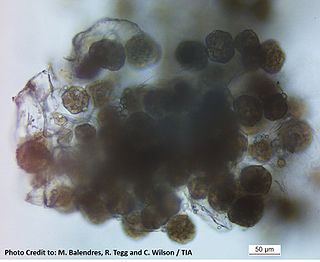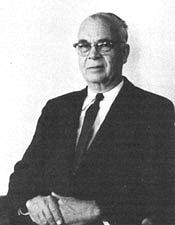Related Research Articles

Agronomy is the science and technology of producing and using plants by agriculture for food, fuel, fiber, chemicals, recreation, or land conservation. Agronomy has come to include research of plant genetics, plant physiology, meteorology, and soil science. It is the application of a combination of sciences such as biology, chemistry, economics, ecology, earth science, and genetics. Professionals of agronomy are termed agronomists.

Norman Ernest Borlaug was an American agronomist who led initiatives worldwide that contributed to the extensive increases in agricultural production termed the Green Revolution. Borlaug was awarded multiple honors for his work, including the Nobel Peace Prize, the Presidential Medal of Freedom and the Congressional Gold Medal, one of only seven people to have received all three awards.
The cereal grain wheat is subject to numerous wheat diseases, including bacterial, viral and fungal diseases, as well as parasitic infestations.

Elvin Charles Stakman was an American plant pathologist who was a pioneer of methods of identifying and combatting disease in wheat. He became an internationally renowned phytopathologist for his studies of the genetics and epidemiology of stem rust. Stakman is credited with improving crop yields both in North America and worldwide as part of the Green Revolution.

Powdery scab is a disease of potato tubers. It is caused by the cercozoan Spongospora subterranea f. sp. subterranea and is widespread in potato growing countries. Symptoms of powdery scab include small lesions in the early stages of the disease, progressing to raised pustules containing a powdery mass. These can eventually rupture within the tuber periderm. The powdery pustules contain resting spores that release anisokont zoospores to infect the root hairs of potatoes or tomatoes. Powdery scab is a cosmetic defect on tubers, which can result in the rejection of these potatoes. Potatoes which have been infected can be peeled to remove the infected skin and the remaining inside of the potato can be cooked and eaten.

Thielaviopsis basicola is the plant-pathogen fungus responsible for black root rot disease. This particular disease has a large host range, affecting woody ornamentals, herbaceous ornamentals, agronomic crops, and even vegetable crops. Examples of susceptible hosts include petunia, pansy, poinsettia, tobacco, cotton, carrot, lettuce, tomato, and others. Symptoms of this disease resemble nutrient deficiency but are truly a result of the decaying root systems of plants. Common symptoms include chlorotic lower foliage, yellowing of plant, stunting or wilting, and black lesions along the roots. The lesions along the roots may appear red at first, getting darker and turning black as the disease progresses. Black root lesions that begin in the middle of a root can also spread further along the roots in either direction. Due to the nature of the pathogen, the disease can easily be identified by the black lesions along the roots, especially when compared to healthy roots. The black lesions that appear along the roots are a result of the formation of chlamydospores, resting spores of the fungus that contribute to its pathogenicity. The chlamydospores are a dark brown-black color and cause the "discoloration" of the roots when they are produced in large amounts.
Soil-borne wheat mosaic virus is a rod-shaped plant pathogen that can cause severe stunting and mosaic in susceptible wheat, barley and rye cultivars. The disease has often been misdiagnosed as a nutritional problem, but this has actually allowed in part for the fortuitous visual selection by breeding programs of resistant genotypes. Soil-borne wheat mosaic virus is part of the genus Furovirus. Members of this genus are characterized by rigid rod-shaped particles and positive sense RNA genomes consisting of two molecules that are packaged into separate particles that code for either replication, mobility, structure or defense against the host. The virus is spread by a fungal-like protist, Polymyxa graminis, whose asexual secondary and sexual primary cycles help the virus spread. The disease produces secondary symptoms from the root cell infection. The disease is a serious contributor to loss in crop yield.

Henry Luke Bolley was an American botanist and plant pathologist known for his work that led to the control or eradication of several major crop diseases. He was also a pioneering college football player and coach.
Plant disease epidemiology is the study of disease in plant populations. Much like diseases of humans and other animals, plant diseases occur due to pathogens such as bacteria, viruses, fungi, oomycetes, nematodes, phytoplasmas, protozoa, and parasitic plants. Plant disease epidemiologists strive for an understanding of the cause and effects of disease and develop strategies to intervene in situations where crop losses may occur. Destructive and non-destructive methods are used to detect diseases in plants. Additionally, understanding the responses of the immune system in plants will further benefit and limit the loss of crops. Typically successful intervention will lead to a low enough level of disease to be acceptable, depending upon the value of the crop.

Fusarium oxysporum f. sp. cubense is a fungal plant pathogen that causes Panama disease of banana, also known as Fusarium wilt. The fungi and the related disease are responsible for widespread pressure on banana growing regions, destroying the economic viability of several commercially important banana varieties.

Harold Henry Flor known as H. H. Flor (1900–1991) was an American plant pathologist famous for proposing the gene for gene hypothesis of plant-pathogen genetic interaction whilst working on rust of flax.

Charlotte Elliott (1883-1974) was a pioneering American plant physiologist specializing in bacterial organisms that cause disease in crops who was the author of a much-used reference work, the Manual of Bacterial Plant Pathogens. She was the first woman to receive a Ph.D. in botany from the University of Wisconsin, Madison.
Stephen Wilhelm was a professor of plant pathology, known for his success in controlling Verticillium wilt. His research on plant hybridization and soil fumigation contributed to revolutionary developments in the strawberry and raspberry industries.
Ernest Robert Sears was an American geneticist, botanist, pioneer of plant genetics, and leading expert on wheat cytogenetics. Sears and Sir Ralph Riley (1924–1999) are perhaps the two most important founders of chromosome engineering in plant breeding.
Kenneth Frank Baker was an American phytopathologist. In his early career he held a number of positions with the United States Forest Service and United States Department of Agriculture. Following a three-year period in Hawaii researching pineapple pathogens, he accepted a position at the University of California, Los Angeles, where he remained for twenty-one years. He was elected as a fellow of the American Association for the Advancement of Science in 1950 and as a fellow of the American Phytopathological Society in 1969. Additionally, he served as the editor of the Annual Review of Phytopathology for five years.
Robert Kent Webster is an American phytopathologist who specialized in pathogens affecting rice during his career at the University of California, Davis. He was the editor of the Annual Review of Phytopathology from 1995–2003.

Stephen Denis Garrett was a British plant pathologist and mycologist who did pioneering work on soil-borne pathogens, root pathology and soil ecology. He was the first to apply ecological concepts to interactions in the soil. Much of his research used as a model system the fungus Gaeumannomyces graminis, which causes the important cereal disease take-all. He also studied Armillaria root rot of trees, among other plant diseases.
2Blades is an agricultural phytopathology non-profit which performs research to improve durable genetic resistance in crops, and funds other researchers to do the same. 2Blades was co-founded by Dr. Roger Freedman and Dr. Diana Horvath in 2004.
John Colhoun was a British mycologist, phytopathologist, and professor of cryptogamic botany. For a one-year term from 1963 to 1964 he was the president of the British Mycological Society.
Ralph Merrill Caldwell was an American plant breeder, mycologist, and plant pathologist. Through his work with the U.S. Department of Agriculture and Purdue University, he developed disease-resistant cultivars for a wide variety of plants, including widely-grown wheat cultivars.
References
- 1 2 3 4 5 "R. James Cook". Washington State University. Retrieved 1 December 2020.
- ↑ Minnesota Department of Health (1937), Birth Index, 1935-2000
- 1 2 "Cook Will Occupy Chair Named in His Honor". Washington State University. Retrieved 1 December 2020.
- ↑ "Preface". Annual Review of Phytopathology. 23. 1985. doi:10.1146/annurev.py.23.060804.100001.
- 1 2 "Kenneth F. Baker and R. James Cook Student Travel Award". American Phytopathological Society. Retrieved 1 December 2020.
- ↑ "R. James Cook". John Simon Guggenheim Memorial Foundation. Retrieved 1 December 2020.
- ↑ "R. James Cook". Plant Health International. Retrieved 1 December 2020.